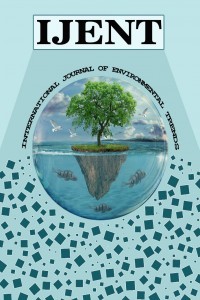Investigation of the retention of oils mixed with water by forming activated carbon added nanofibers
Investigation of the retention of oils mixed with water by forming activated carbon added nanofibers
Heavy metals, waste oils, garbage, petroleum-derived polymers, animal and medical wastes cause pollution in water resources. The resulting pollution poses a danger to aquatic creatures and harms these creatures. In this study, obtaining wettable nanofibers for dewatering of oils mixed with water was investigated. It is aimed to increase the contact angle value by adding activated carbon produced from apricot kernels to the nanofibers produced from waste polystyrene. As a result, oil-water separation was carried out by increasing the hydrophobicity of the nanofiber and preserving its oil-holding property. In the experiments, 4 different concentrations of solutions were prepared using waste polystyrene and dimethylformamide (DMF)/(C3H7NO) and nanofibers were produced by electrospinning device. According to the SEM images, it was determined that the sample with the best fibre structure belonged to the 17% solution. On top of this, new nanofibers were produced by adding 5% and 10% by mass of activated carbon made from apricot kernels to the same solution. The contact angle values of the produced nanofibers were measured and it was observed that the hydrophobicity of the 10% activated carbon added nanofiber was the highest. In order to determine the water and oil absorption of the sample with the best structure and activated carbon added samples, it was tested by dropping 2 mL of water and 2 mL of oil on the experimental setup. As a result, it has been proven that this material, which has hydrophobic and oleophilic properties, can be used in oil/water separation processes, and the oil-derived waste polystyrene materials that cause water pollution are recycled.
Keywords:
Water pollution nanofibre, oleophilic, hydrophobic, apricot kernel, activated carbon,
___
- [1] Yıldız, K., Sipahioğlu, Ş., Yılmaz, M., (2008), "Çevre bilimi ve eğitimi," Gündüz Eğitim ve Yayıncılık, Ankara, ISBN: 978-925-6859-86-5 S.104-105.
- [2] https://sifiratik.gov.tr/bitkisel-atik-yag
- [3] Wang, S., Liu, K., Yao, X. ve Jiang, L., (2015), "Bioinspired surfaces with superwettability: new ınsight on theory, design, and applications", Chemical Reviews, 115 (16), 8230−8293.
- [4] Yalçın Erik, N., (2015), “ Petrol tankeri kazaları ve neden olduğu çevre kirliliği”, Mavi Gezegen (20), 1-11.
- [5] Özgür, H., Gemici, Z., Bayırdır, M., (2007), "Akıllı nanoyüzeyler", Bilim ve Teknik, Sayı: 473, s. 52-56.
- [6] Ordu, F., (2012), "Metalik Yüzeylerde Kimyasal İşleme Yöntemi İle Hidrofobik Yüzey Oluşturulması" Trakya Üniversitesi, Fen Bilimleri Enstitüsü, Makine Mühendisliği Ana Bilim Dalı, Yüksek Lisans Tezi.
- [7] Özdemir, G., (2017), "Sıvıların Islatma Yetenekleri ve Temas Açısı", İnovatif Kimya Dergisi, 36. [8] Aygül, E., (2019). "Yeni Nesil Süperhidrofobik Kaplamaların Hazırlanması Ve Yağ/Su Ayırma İşlemlerindeki Kullanımları" Gazi Üniversitesi, Yüksek Lisans Tezi, Fen Bilimleri Enstitüsü, Kimya Ana Bilim Dalı, 93 sayfa.
- [9] Teğin, Ş. Ö., Şahin, Ö., Baytar, O., & İzgi, M. S., (2020), "Preparation and characterization of activated carbon from almond shell by microwave-assisted using ZnCl2 activator" International Journal of Chemistry and Technology, 4(2), 130-137.
- [10] Ozmak, M. Y., (2010), "Biyokütle atıklardan aktif karbon üretimi", Doktora Tezi, Ankara Üniversitesi, Fen Bilimleri Enstitüsü, Kimya Mühendisliği Anabilim Dalı, 85 sayfa.
- [11] Zeytuncu, B. (2014), "Elektrospinning Tekniği ve Uv Işımasının Eşzamanlı Olarak Uygulanması ile Nanofiber Membranların Hazırlanması ve Kıymetli Metallerin Adsorpsiyonunda Uygulanması" Doktora Tezi, İstanbul Teknik Üniversitesi, Fen Bilimleri Enstitüsü, Kimya Anabilim Dalı, 172 sayfa.
- [12] Huang, Z. M., Zhang, Y. Z., Kotaki, M., & Ramakrishna, S., (2003), "A review on polymer nanofibers by electrospinning and their applications in nanocomposites", Composites science and technology, 63(15), 2223-2253. [13] Dzenis, Y., (2004), "Spinning continuous fibers for nanotechnology", Science, 304 (5679), 1917-1919.
- [14] Ramakrishna, S., Fujihara, K., Teo, W. E., Yong, T., Ma, Z., & Ramaseshan, R., (2006), "Electrospun nanofibers: solving global issues", Materials Today, 9 (3), 40-50.
- [15] Süslü, A., (2009), "Elektro-eğirme yöntemi ile nanofiber ve nanotüp üretimi", Doktora Tezi, Dokuz Eylül Üniversitesi, Fen Bilimleri Enstitüsü, Kimya Anabilim Dalı, 93 sayfa.
- [16] Formhals, A., 1934, US Patent 1975504.
- [17] Subbiah, T., Bhat, G. S., Tock, R. W., Parameswaran, S., & Ramkumar, S. S., (2005), "Electrospinning of nanofibers", Journal of applied polymer science, 96(2), 557-569.
- [18] Kozanoğlu, G. S., (2006), "Elektrospinning yöntemiyle nanolif üretim teknolojisi", Yüksek Lisans Tezi, İstanbul Teknik Üniversitesi, Fen Bilimleri Enstitüsü, 59 sayfa.
- [19] Evcin, A., Ersoy, B., & Bezir, N. Ç., (2019), "Elektroeğirme Yöntemiyle Ag Katkılı Karbon Nanoliflerin Sentezi", Nevşehir Bilim ve Teknoloji Dergisi, 8, 88-97.
- [20] Ding, B., Kim, H. Y., Lee, S. C., Shao, C. L., Lee, D. R., Park, S. J., & Choi, K. J., (2002), "Preparation and characterization of a nanoscale poly (vinyl alcohol) fiber aggregate produced by an electrospinning method", Journal of Polymer Science Part B: Polymer Physics, 40 (13), 1261-1268.
- [21] Nataraj, S. K., Yang, K. S., & Aminabhavi, T. M., (2012), "Polyacrylonitrile-based nanofibers—A state-of-the-art review", Progress in polymer science, 37 (3), 487-513.
- [22] Çatabaş, F., (2019), "Mikroplastiklerin su ortamlarına ve canlılara etkileri", web sayfası: http://content.lms.sabis.sakarya.edu.tr/Uploads/69377/39294/fatih_%C3%A7atalba%C5%9F_sunu m.pptx., erişim tarihi: 14.04.2019.
- [23] Eriksen, M., Borgogno, F., Villarrubia-Gómez, P., Anderson, E., Box, C., & Trenholm, N. (2020). Mitigation strategies to reverse the rising trend of plastics in Polar Regions. Environment international, 139, 105704.
- [24] Zhuo, H., Hu, J., Chen, S., & Yeung, L., (2008), "Preparation of polyurethane nanofibers by electrospinning" Journal of Applied Polymer Science, 109 (1), 406-411.
- [25] Chu, Z., Feng, Y., & Seeger, S., (2015), "Oil/water separation with selective superantiwetting/superwetting surface materials", Angewandte Chemie International, 54 (8), 2328-2338.
- ISSN: 2602-4160
- Başlangıç: 2017
- Yayıncı: Muhammed Kamil ÖDEN
Sayıdaki Diğer Makaleler
Evaluation of Hazardous Wastes in Terms of Occupational Health and Safety, and Environmental Ethics
THE EFFECT OF BEET (Beta vulgaris) JUICE SOLUTIONS ON SECRET Icing
THE CONCEPT OF PUBLIC AESTHETICS FROM ENVIRONMENTAL LAW
Investigation of the retention of oils mixed with water by forming activated carbon added nanofibers
Mustafa KARABİLGİN, Emine AĞAÇAYAK, Berra Gül SAFRAN, Merve AĞAÇAYAK, Tevfik AĞAÇAYAK
